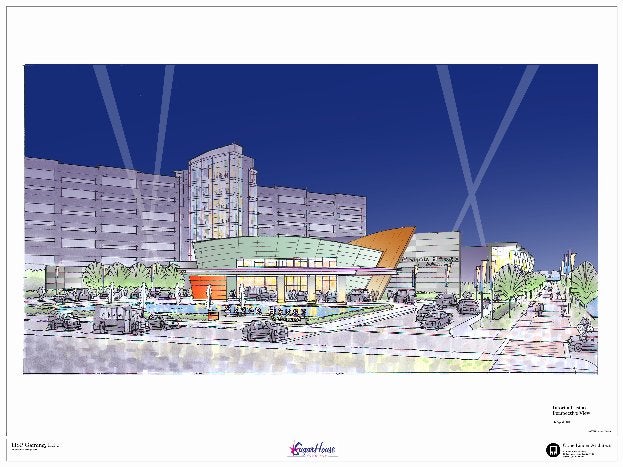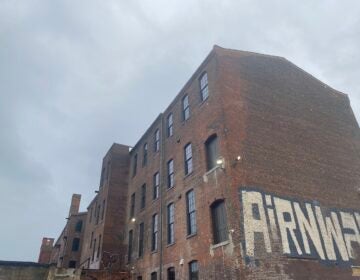SugarHouse, Mayor unveil casino re-design

A new SugarHouse design unveiled by casino and city officials Monday calls for a smaller building footprint, first-floor retail space, and more public access to the river.
The Nutter Administration – which recently gave up efforts to convince SugarHouse to move off the waterfront in order to concentrate on a push for a new design – likes the revisions. And the city appreciates the jobs and host fees SugarHouse projects it will generate.
But some significant hurdles remain before the plans become reality – including financial ones. SugarHouse does not have loans in place for even the interim casino that would be a space-holder for the permanent facility. And while city officials are pleased, some state-level elected officials have vowed to continue their fight against the waterfront location. Many neighborhood groups have vowed to do the same.
None of this seemed to damper the mood at the press conference where city and casino officials made the design change announcement.
https://www.youtube.com/watch?v=hQYTggZJCYg
“My administration supports the concept drawings in the proposed SugarHouse plan modifications and we will do everything within our power to assist SugarHouse’s efforts to move forward with this design and to open an interim facility by this time next year,” Mayor Michael Nutter said. “These are changes that we sought, and I want to express my appreciation to SugarHouse for listening to our ideas and working with us.”
https://www.youtube.com/watch?v=xDvhdreQgMw
“We look forward to getting our facility open as soon as possible, creating new career opportunities, and generating hundreds of millions of dollars in tax revenue to the City and Commonwealth,” said Bob Sheldon, President and Chief Operating Officer for SugarHouse Casino.
“It’s about time,” said Donna Tomlinson, a member of Fishtown Action, a community group that supports casinos. She has lived all of her 54 years in the neighborhood.
Before construction begins, SugarHouse must acquire $160 million in loans to build the interim facility. The revised plans must get the blessing of the Pennsylvania Gaming Control Board, the Philadelphia City Planning Commission and City Council. Part of the redesign calls for using a parcel of land north of SugarHouse’s Delaware Avenue site for parking – a parcel the casino does not own, and does not have PGCB approval to use.
The casino filed a design-change petition with the Gaming Control Board Monday. This is its second pending petition. The first, for which a hearing has not yet been scheduled, is a request for an extension on its operating license, which expired in December. No hearing has been scheduled for either.
Planning Commission Executive Director Alan Greenberger said he expected the redesign would get city planning approval, since he and other administration officials are pleased with it. First District City Councilman Frank DiCicco said he would soon introduce legislation that would get council approval for the redesign. He said he hopes it will be passed before council breaks for the summer.
https://www.youtube.com/watch?v=G6X6bFwFBbQ
As for the financing, Sheldon said he expects no problems there, despite the economy. His reason: SugarHouse’s team of investors has about $160 million in equity in the project. (In other words, they’ve paid for what’s been done so far themselves, and have no debt.) The total projected cost of the casino has been $650 million. The redesign will add an as-yet undetermined amount, Sheldon said.
Design changes include: The addition of a third point of public access to the water through the SugarHouse site. A reduction in the footprint of the buildings, created by placing part of the gaming floor beneath a parking garage. The gaming floor and food court area will be located at street level, where the pedestrians are situated. Sites for future retail and a hotel are out along Delaware Avenue. The promenade that originally jutted out into the water is gone, replaced by a softer, more natural waterfront edge.
(Despite the disappearance of the promenade, SugarHouse will still need the Army Corps of Engineers permit it has been working on for a year, said Terry McKenna, project executive for SugarHouse’s general contractor, due to some sewer-related issues. But the interim casino can be built without the Corps permit, he said.
Tomlinson said she likes the new design. The more natural water’s edge will be “very pretty” and give the casino property “A Penn Treaty Park feel,” she said – although she was looking forward to the promenade.
City officials asked for these changes so that the casino would fit in better with the Vision for the Central Delaware and the corresponding Action Plan – documents put together by Penn Praxis after more than a year of community input. Nutter has endorsed the documents, and Greenberger has said he will recommend the Planning Commission use the principles they contain to plan for future waterfront development at the Commission’s April 21 meeting.
But some of what makes the revised plan a closer fit won’t be realized until Phase II. The interim casino would open behind parking lots with space for about 420 cars, for example.
Phase II timing, Sheldon said, “depends on market conditions.”
“Phase II is where it’s not a strip mall anymore,” said Matt Ruben, a member of the Central Delaware Advocacy Group – an organization charged with monitoring the implementation of the Action Plan and representing the views of waterfront communities in the process.
Until then, “I see a gigantic sea of parking – a textbook example of the kind of development no one wants to see on riverfront,” he said. “And since they currently have no financing, I have serious concerns whether they will ever get beyond Phase I, and therefore replace the sea of parking with a more appropriate use.”
Ruben, who represents Northern Liberties Neighbors Association, was also disappointed that the revisions were drawn up without public meetings for community input.
The parking makes PennPraxis Executive Director Harris Steinberg cringe, too. He said he can live with the big parking lot at the beginning of the plan, because that still allows for future, up-to-the-street development in the future. But if the casino is built according to this latest design, there will be nearly as many parking spaces as there are slot machines, he said – and that encourages way too many cars.
“I think it’s a step in the direction we recommended, but it’s still intensely auto-centric,” Steinberg said. Philadelphia should be focused on development that encourages mass transit use, he said.
Greenberger said city officials were still discussing the design proposals with SugarHouse, and parking was one of the issues he wants to talk more about. “We’re very focused on what Phase I is like,” he said, because economic uncertainty means it might stick around for awhile.
Some of the city officials giving the redesign its blessing yesterday used to fiercely oppose against any casino on the waterfront.
DiCicco said the economy – and a series of defeats in State Supreme Court – have had an impact on his casino stance. DiCicco was among a group of elected officials who fought the proposed waterfront locations of both SugarHouse and Foxwoods, which now hopes to build at Market East instead. He now supports both the SugarHouse redesign and a Market East location for Foxwoods.
DiCicco said he started fighting the casinos in 2006, but “2009 is not 2006. No longer do we enjoy an unprecedented housing boom. The City no longer enjoys a surplus. Our employment rate is quickly rising.” Nutter spoke of purse strings, too, saying the construction of the interim facility would create 500 construction jobs and provide 500 permanent jobs, the full build-out would create an additional 600 construction jobs and about that many full-time employees. SugarHouse also estimates the City will receive $11 million in host fees annually, beginning next year, and $18 million annually after the project is complete. (Nutter’s job comments prompted FACT co-founder Maggie O’Brien to quip, “He stole my line!”)
“I’m not going to stand here today and tell the public that I love this project or this location,” DiCicco said. “But I will say I’m putting the past behind us. The fight is over.”
But the fight isn’t over for everyone. And while the Fishtown Action community group formed to fight for the casino and the opportunities they believe it will bring to the neighborhood, the Fishtown Neighbors Association and a large contingent of other waterfront neighborhoods continue to fight both casinos.
So does the activist group Casino-Free Philadelphia. “It doesn’t matter what it looks like. It’s a joke to think that this changes anything,” said Paul Boni, Casino-Free attorney.
As the group’s name implies, Casino-Free doesn’t want any casinos in Philadelphia – at least not near neighborhoods. They believe costs related to gambling addiction, an increased police presence and other factors will outweigh any benefit in jobs and host fees. And they say casinos will ruin property values and hamper local businesses.
But Boni sounded almost as pleased with Monday’s announcement as SugarHouse officials and the mayor did. “They don’t have any money,” he said. “They have to get all of their approvals all over again … there is no construction in sight. We’re elated.”
State Rep. Michael O’Brien – who supports Foxwoods’ Market East location – isn’t ready to give up the fight to move SugarHouse, either. Like Boni, O’Brien says it’s not about design, but land use, and a casino is not a good use for waterfront land. “I’m sorely disappointed at the actions of the Administration,” he said of the city’s support of the redesign.
O’Brien maintains that any delays in SugarHouse’s opening have not been caused by law makers or activists, but by the casino’s choice of site, and the many permits that opening there requires. Monday, he said that SugarHouse officials were again setting themselves up for failure.
State gaming law says a casino can get no more than a 24-month extension on its operating license – by then, the slots parlors must be operational. A SugarHouse attorney said Monday that the casino’s temporary facility would more than meet that requirement, since it is set to open in about a year. O’Brien disagrees, saying only the permanent facility will meet statutory requirements. McKenna, project executive for SugarHouse’s general contractor, estimated it would take an additional 20 months after the opening of the interim casino to open Phase I.
Then there’s the issue of the parcel north of the site that SugarHouse does not own, but wants to use for parking.
“We’re in conversation with the owner of the property,” SugarHouse spokeperson Leigh Whitaker said.
That doesn’t really matter, said O’Brien, because gaming law says casinos must build on the land approved for their project by the state gaming control board. If SugarHouse owned it, it would still be considered “an associated area, which is prohibited by the statute,” O’Brien said. The language was included to prevent the state’s casinos from doing things like building an addition across the road and connecting it to their original site with a bridge, he said.
“We are building a casino on our approved site,” Whitaker said. She declined to comment further on the topic.
O’Brien said he and Sen. Lawrence Farnese will be adding these matters to the points they’ve already made to the Gaming Control Board regarding SugarHouse.
The Gaming Control Board will be hearing from SugarHouse and Foxwoods at its meeting in Harrisburg on Wednesday. The Board summoned casino officials to ask what’s taking them so long to get running in Philadelphia. Both casinos have convinced the State Supreme Court that it’s the city’s fault. Despite the city’s adamant insistence that officials were not stalling, but progressing with due diligence, the court appointed Special Masters to oversee dealings between both casinos and the city.
Community activists who oppose the casino locations are heading to Harrisburg by the bus load.
Contact the reporter at kelliespatrick@gmail.com.
Read SugarHouse’s petition to the Gaming Control Board, see the interim casino design and compare the old and new casino designs for Phase I and Phase II by clicking below:
WHYY is your source for fact-based, in-depth journalism and information. As a nonprofit organization, we rely on financial support from readers like you. Please give today.






